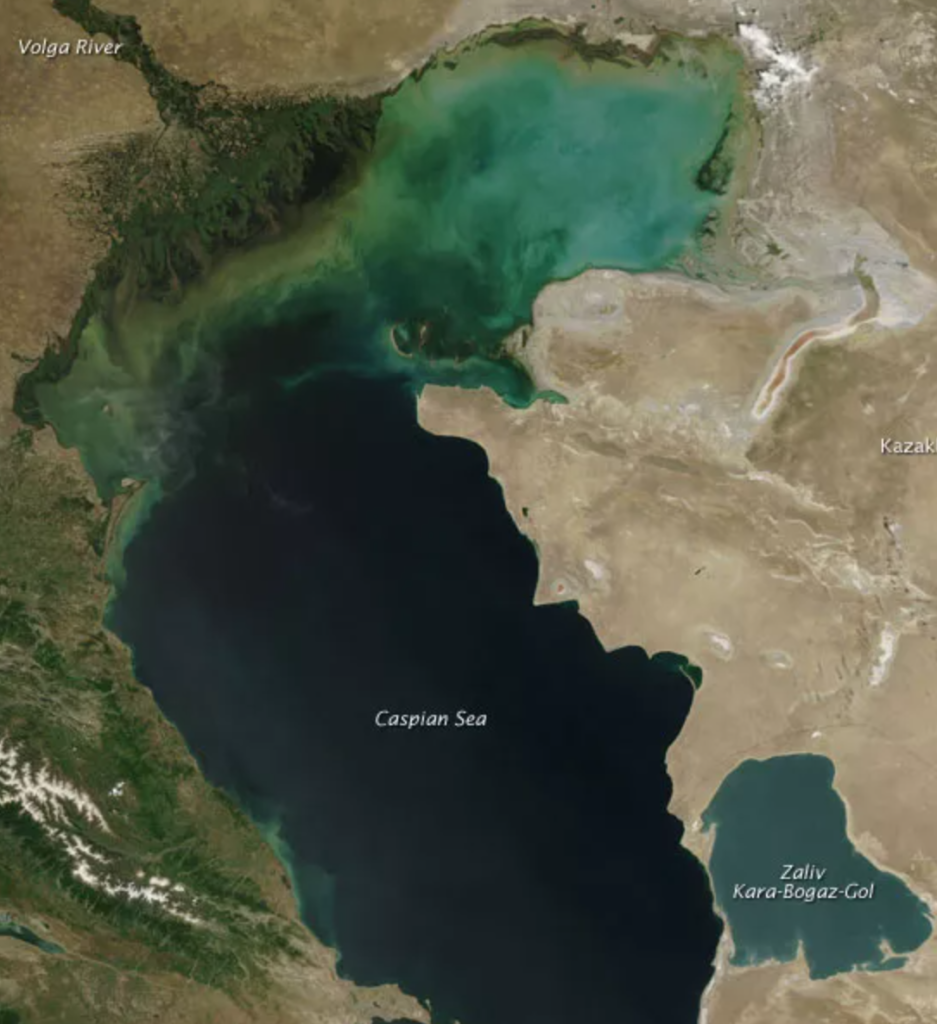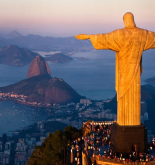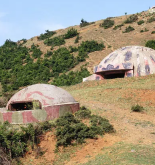Did you know the Caspian Sea, the Dead Sea, and the Aral Sea are all lakes, not seas? Indeed, the Caspian is the world’s biggest lake. Additionally, the Russian lake Baikal holds more water than the five Great Lakes of North America combined (Superior, Huron, Michigan, Erie, and Ontario), despite its surface being nearly eight times smaller. This is owing to the fact that its average depth is eight times larger. Indeed, it is the world’s deepest lake, containing about 20% of the world’s fresh water.
Why are the Caspian Sea and Aral Sea considered lakes?
By surface area, the Caspian Sea is the world’s biggest inland body of water. It is situated at the crossroads of Europe and Asia, with the Caucasus Mountains to the west and Central Asian steppes to the east. It is bounded on the northwest by Russia, on the west by Azerbaijan, on the south by Iran, on the southeast by Turkmenistan, and on the northeast by Kazakhstan.
Ownership of the sea’s resources is a point of contention amongst the nations that surround it. The Caspian Sea is abundant in oil and natural gas, making access to it a high-risk endeavor. The Caspian Sea’s complex sociocultural and political dimensions, as well as its geographic and natural characteristics, making it an intriguing subject for scholars.

“In some ways, it unites multiple nations that do not share a physical border, while also acting as a buffer between governments with divergent politics and philosophies,” said Michael Kukral, author and geography professor at Ohio’s Rose-Hulman Institute of Technology.
Aral Sea, Kazakh Aral Tengizi, Uzbek Orol Dengizi, a once-large saltwater lake of Central Asia. It straddles the boundary between Kazakhstan to the north and Uzbekistan to the south.
Figures and facts
- Surface area: 143,244 square miles (371,000 square kilometers)
- Maximum depth: 3,363 feet (1,025 meters)
- Average depth: 692 feet (211 m)
- Length: 640 miles (1,030 km)
- Maximum width: 270 miles (435 km)
- Minimum width: 124 miles (200 km)
- Coastline area: 4,237 miles (6,820 km)
- Water volume: 18,761 cubic miles (78,200 cubic km)
- Altitude: 72 feet below sea level (22 m below sea level). The Caspian Depression, a flat, lowland region encompassing the northern area of the Caspian Sea, is one of the lowest points on Earth.
- Baku, Azerbaijan, is the largest city on the Caspian Sea.
Climate of the Caspian Sea
The Caspian Sea is divided into three separate sections. “The north is characterized by a low-lying coastal plain that is sandy, hot, and humid,” Kukral explained. This location features the Caspian’s shallowest water, at roughly 20 feet (4 to 5 m).
The Middle Caspian sinks to a depth of around 620 feet (190 m). According to the New World Encyclopedia, the western seabed is steeply sloping, whilst the eastern bottom is softly gradating. The shorelines are rocky.
The Southern Caspian reaches depths of about 3,300 feet (1,000 m) and contains the majority of the world’s fresh water. Kukral characterized the southern coasts as being flanked with “cliffs and outcroppings overlooking the lake, which were frequently inhabited by Persian aristocrats.”
The Caspian Sea is an endorheic body of water, which means it lacks natural exits. According to Natural History Magazine, the Caspian Sea is fed by over 130 rivers, none of which originate in the east. The Volga River is the principal tributary in the north, providing around 80% of the inflowing water. Additionally, the Ural River in the north and the Kura River in the west are important tributaries. The fresh water inflowing from these rivers dilutes the water. Salinity varies from north to south by 1.0 to 13.5 parts per thousand (ppt), according to Casp Info, a European Union-funded data management initiative regarding the Caspian Sea. By comparison, the North Atlantic Ocean, according to Encyclopedia Britannica, has a salinity of 37 parts per trillion.
Due to the lack of an outlet, the quantity of rainfall in the river basins can have a significant influence on the Caspian Sea’s water level, according to GRID-Arendal, an environmental information center. Human-built dams created during the previous two centuries have also altered river levels. Other possible explanations include tectonic movement and sedimentation variations. Climate change has been a significant factor in recent years. Increased rainfall in Russia as a result of increasingly intense weather patterns has increased the volume of water entering the Volga River and Caspian Sea. However, scientists have observed signs that general rising temperatures may contribute to the Caspian Sea’s drying off.
According to Natural History Magazine, scientists believe that human-caused causes, such as oil spills, which reduce evaporation by coating the water with a thin film, account for 3 to 5% of water level variance.
According to New World Encyclopedia, the Caspian Sea has roughly 50 tiny, largely deserted islands. The majority are located in the north, but the largest, Ogurja Ada, is located in the south.
According to Lakepedia, the Caspian Sea is adjacent to the world’s biggest lagoon. The Kara-Bogaz Gol lagoon, which covers 6,949 square miles (18,000 square kilometers), is located on the eastern shore of the Caspian Sea and is separated from it by sand bars. Between the Caspian Sea and Kara-Bogaz Gol, a dam was erected in 1980 but was demolished in 1992 due to the effect it had on water levels.
Iran is located on the Caspian Sea’s southern shore.
Is it a lake or is it a sea?
Regardless of its name, the Caspian Sea is classified as a lake or a sea. Kukral, like many scholars, refers to it as a lake. It was formerly classified as a sea due to its vastness and salinity, yet it has many traits with lakes. The majority of the ambiguity stems from the absence of generally agreed-upon definitions for oceans and lakes.
Seas are sometimes defined by their salt water connection to the ocean or another sea, which the Caspian Sea does not have. According to the National Oceanic and Atmospheric Administration, seas are often partially surrounded by land, whereas the Caspian Sea is totally encircled by land. Typically, seas are made up of salt water. While the Caspian Sea does not contain fresh water, its salinity is reduced by inflows of fresh water, particularly towards the north.
The distinction between a lake and a sea has political and economic repercussions, Hanna Zimnitskaya stated in a 2011 paper for the Journal of Eurasian Studies. If the Caspian Sea is considered a lake, she said, the United Nations and international law have no jurisdiction over its waters. If the body of water is a sea, international organizations can have a say in how it is used.
This is especially critical given the country’s energy resources. “The Caspian Sea’s petroleum deposits make it an economic natural resource and a political problem of access and ownership,” Kukral explained.
If the Caspian Sea were a lake, it would hold 40% of the world’s lake water. “It is the largest lake in the planet,” Kukral explained.
History
The Caspian Sea is a relic of the ancient Paratethys Sea, which existed 50 million to 60 million years ago as part of the Tethys Ocean. According to WorldLakes.org, the Tethys Ocean was connected to the Atlantic and Pacific seas during the time. Continental platforms moved throughout millennia, and the Tethys Ocean lost its link to neighboring oceans. Much of it evaporated during hot and dry periods, resulting in the formation of the Caspian Sea, Black Sea, and Aral Sea. The age of the Caspian Sea is considered to be around 30 million years. The Tethys Sea’s saline water survived and contributes to the Caspian Sea’s salinity.
Archaeologists think that people occupied the area circa 75,000 years ago, according to the New World Encyclopedia. It is named after the Caspi Tribe, which established a settlement on the island’s southwest shore. By the tenth century, little oil wells dot the Caspian Sea’s coastlines, according to the Azerbaijan Republic’s State Oil Company (SOCAR). In the 16th century, Europeans became aware of the resource-rich region and began going to the Caspian Sea to investigate. In 1820, the first offshore oil well was drilled. Today, the area is dominated by the oil and gas sector. Other enterprises near the coastlines include salt extraction, fishing, and tourism.
According to GRID-Arendal, the Caspian Sea’s water level has changed throughout history. Between the mid-nineteenth and late twentieth centuries, the sea level fluctuated by more than 12 feet (3.6 m). In 1977, the Caspian Sea overflowed, wreaking havoc. Numerous other floods have happened since then. According to the Pars Times, the water level has increased over 7.4 feet (2.2 m) since 1978.
Beluga caviar is made from the eggs of beluga sturgeons, the world’s biggest freshwater fish. The Caspian Sea produces the bulk of the world’s beluga caviar.
Ecosystem
Kukral said that the Caspian Sea is renowned for its richness. According to the World Wildlife Fund, it is regarded an autonomous zoogeographical zone due to its unique characteristics.
The coasts of several locations are littered with shallow saline ponds that are ideal habitats for birds, tiny fish, crabs, and invertebrates. Birds are abundant throughout the year, and several species utilize the Caspian Sea as a wintering ground. According to Casp Info, the Caspian Sea is home to around 2,000 animal species and subspecies. Around 400 of species are native to the region, including the Caspian gull, Caspian turn, spur-thighed tortoise, Horsfield’s tortoise, Caspian white fish, Caspian salmon, and the Caspian seal, the region’s sole aquatic animal. According to the Smithsonian Institution, nearby petroglyphs indicate that dolphins and porpoises may have formerly existed in the Caspian Sea.
The beluga sturgeon, also known as the European or Caspian sturgeon, is the region’s most renowned and economically significant mammal. The beluga sturgeon, the world’s biggest freshwater fish, is best known for its eggs, which are turned into caviar. The Caspian Sea produces the bulk of the world’s beluga caviar. This has resulted in overfishing concerns. Additionally, dams have obliterated a large portion of their spawning sites, and chemicals used in land agriculture have reduced their productivity. According to the World Wildlife Fund, the beluga sturgeon is currently severely endangered.
According to the World Wildlife Fund, the Volga River Delta in the North Caspian is home to a diverse array of unique or uncommon aquatic plants. Turkmenistan’s section of the Caspian coastlines is deemed degraded in terms of vegetation. Nonetheless, certain specific salt-resistant plants, such as shrubs and sagebrush, exist.
Threats
The Caspian Sea confronts several ecological concerns, which have an impact on the region’s human population, flora and wildlife, economy, and overall environment. “As with other international inland bodies of water, today’s issues concern access, use, pollution/water quality, and resources,” Kukral explained.
According to Casp Info, the Caspian region’s extensive oil and gas development has resulted in major water, air, and land pollution, natural resource depletion, harm to wildlife and plant life, ecosystem disruption, desertification, and loss of biological and landscape variety. Oil spills, garbage from onshore industrial and municipal facilities, untreated sewage, and rubbish brought in by rivers all contribute significantly to land and water pollution. According to the Pars Times, around 1 million cubic meters (264 million gallons) of untreated industrial effluent is discharged into the Caspian each year.
Flooding has been exacerbated by increasing sea levels, and when the water washes over coastline oil wells, it transports oil and other contaminants inland. According to GRID-Arendal, scientists estimate that on- and offshore drilling operations in the Caspian region produce between 15 and 20 million tons of CO2-equivalent per year. This has exacerbated the area’s air pollution concerns.
Environmental degradation has resulted in major health concerns for people of the Caspian Sea’s five nations, who inhale contaminants through the air, drinking water, food, and swimming. According to the Pars Times, Kazakhstan’s Caspian region has a fourfold prevalence of blood disorders, TB, and intestinal illnesses compared to the rest of the nation. Cancer rates are also higher than usual in the five nations surrounding the Caspian Sea. Sumgayit and Baku were intensively industrialized during the Soviet period. Today, the seas surrounding these settlements are ecological wasteland. Human stillbirths and miscarriages are more prevalent in coastal locations than in inland areas.
Addressing any of these issues is exceedingly difficult due to the five countries’ ownership conflicts. “Who is accountable for water quality management? The Caspian Sea is shared by five countries, but who profits from the oil? Where are the lake’s limits or jurisdiction?” As Kukral stated. These pervasive questions are difficult to address and can impede cooperative efforts.



